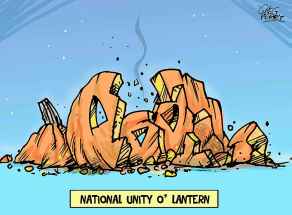Spending more doesn’t mean waiting less for health care, report makes clear
Read this article for free:
or
Already have an account? Log in here »
To continue reading, please subscribe:
Monthly Digital Subscription
$0 for the first 4 weeks*
- Enjoy unlimited reading on winnipegfreepress.com
- Read the E-Edition, our digital replica newspaper
- Access News Break, our award-winning app
- Play interactive puzzles
*No charge for 4 weeks then price increases to the regular rate of $19.00 plus GST every four weeks. Offer available to new and qualified returning subscribers only. Cancel any time.
Monthly Digital Subscription
$4.75/week*
- Enjoy unlimited reading on winnipegfreepress.com
- Read the E-Edition, our digital replica newspaper
- Access News Break, our award-winning app
- Play interactive puzzles
*Billed as $19 plus GST every four weeks. Cancel any time.
To continue reading, please subscribe:
Add Free Press access to your Brandon Sun subscription for only an additional
$1 for the first 4 weeks*
*Your next subscription payment will increase by $1.00 and you will be charged $16.99 plus GST for four weeks. After four weeks, your payment will increase to $23.99 plus GST every four weeks.
Read unlimited articles for free today:
or
Already have an account? Log in here »
Hey there, time traveller!
This article was published 31/10/2019 (2230 days ago), so information in it may no longer be current.
If spending more tax dollars on health care was the answer to reducing wait times, Manitoba would have among the shortest delays in the country.
Despite being among the provinces with the highest public-sector spending on health care, Manitoba still lags behind the Canadian average in key hospital wait times.
Manitoba health-care spending near Canadian average
Posted:
While all provincial and territorial governments are shelling out more for health care in Canada, Manitoba lives up to its reputation as the middle province by spending in the centre of the pack, according to new data published by the Canadian Institute for Health Information (CIHI) Thursday.
Public-sector spending on health care in Manitoba, which makes up roughly 70 per cent of all health-care spending in the province, was $5,434 per person in 2017, according to a Canadian Institute for Health Information report released this week.
That’s the third-highest among the provinces, behind only Newfoundland ($6,019) and Saskatchewan ($5,536).
But Manitoba still has among the highest wait times in areas such as hip- and knee-replacements, cataract surgery and hospital emergency rooms.
Only 53 per cent of Manitoba patients waiting for hip-replacement surgery met the 182-day benchmark in 2017, according to CIHI data. The national average was 76 per cent.
Wait times for knee-replacement surgery in Manitoba were even worse in 2017 with just 43 per cent meeting the 182-day benchmark. The national average was 68 per cent.
Cataract surgery delays were among the worst in the country in 2017 with only 32 per cent of patients getting their surgery within the 112-day benchmark, well below the national average of 71 per cent.
We often hear the argument — particularly from opposition parties and public-sector unions — that if Manitoba only spent more on health care, we wouldn’t have such long wait times. However, the evidence shows that relatively higher spending on its own doesn’t necessarily improve results. It’s the same at the national level.
CIHI has reported that Canada is one of the biggest spenders on health care (as a percentage of the economy) among Organization for Economic Co-operation and Development countries. Yet this country has some of the worst outcomes when it comes to accessing health-care services.
Meanwhile, wait times in Winnipeg emergency rooms continued to climb in September. The median wait time for all city hospitals was just over two hours. That’s more than 30 minutes longer than it was for the same month in 2018. The longest wait time for nine out of 10 patients at 5.3 hours was more than an hour longer than it was a year earlier.

!function(e,i,n,s){var t=”InfogramEmbeds”,d=e.getElementsByTagName(“script”)[0];if(window[t]&&window[t].initialized)window[t].process&&window[t].process();else if(!e.getElementById(n)){var o=e.createElement(“script”);o.async=1,o.id=n,o.src=”https://e.infogram.com/js/dist/embed-loader-min.js”,d.parentNode.insertBefore(o,d)}}(document,0,”infogram-async”);
Part of the increase is due to the Winnipeg Regional Health Authoritiy’s clinical consolidation plan, which includes the conversion of three ERs into urgent-care centres.
St. Boniface Hospital’s ER has been the hardest hit under the changes. Its median ER wait times have jumped nearly an hour over the past year. The longest wait time for nine of 10 patients soared more than two hours, to 6.8 hours, compared to September 2018.
It’s bad news. But Winnipeg has had among the longest ER wait times in the country for the past several years, long before Premier Brian Pallister’s government began its health-care reform plans.
Those wait times are largely unchanged from what they were under the previous NDP government. Median wait times have been hovering between 1.5 and just over two hours for the past five years. (They fluctuate seasonally). That’s well above the national average of just over an hour.
It’s pretty tough to argue Manitoba’s health-care system has been underfunded, especially when compared to other provinces and other OECD countries.
It’s further evidence that higher health-care spending doesn’t necessarily translate into better results. Manitoba’s public-sector spending on health care grew an average of just over five per cent a year per capita (adjusted for inflation) between 1997 and 2017, according to CIHI data tables. Those are substantial increases.
It’s pretty tough to argue Manitoba’s health-care system has been underfunded, especially when compared to other provinces and other OECD countries.
Governments need to figure out how to get better results for the money they spend on health care. The Pallister government says it’s attempting to do that through its reforms, which have resulted in some pockets of success, including a decline in wait times for personal-care homes.
But wait times are still largely unchanged. It’s still too soon to judge the success or failure of those reforms overall. But there’s no doubt change was long overdue.
What we do know for certain is simply throwing more money at health care is not the answer.
tom.brodbeck@freepress.mb.ca

Tom Brodbeck is an award-winning author and columnist with over 30 years experience in print media. He joined the Free Press in 2019. Born and raised in Montreal, Tom graduated from the University of Manitoba in 1993 with a Bachelor of Arts degree in economics and commerce. Read more about Tom.
Tom provides commentary and analysis on political and related issues at the municipal, provincial and federal level. His columns are built on research and coverage of local events. The Free Press’s editing team reviews Tom’s columns before they are posted online or published in print – part of the Free Press’s tradition, since 1872, of producing reliable independent journalism. Read more about Free Press’s history and mandate, and learn how our newsroom operates.
Our newsroom depends on a growing audience of readers to power our journalism. If you are not a paid reader, please consider becoming a subscriber.
Our newsroom depends on its audience of readers to power our journalism. Thank you for your support.













